Neglecting your hip abductors can mess up your walk, sleep and balance
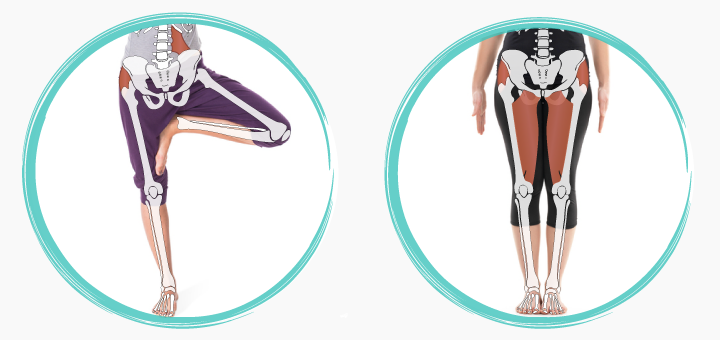
A few months ago, this video of Jean Claude van Damme doing a split between two moving trucks made quite a stir and produced several copycats trying to do something similar. Do not try this at home! Mr Van Damme continues to demonstrate remarkable strength and flexibility in his inner and outer thigh muscles. And if you do not harbor the aspirations of doing splits between the trucks (or any splits, really), should you just forget about those muscles? Today, we will explore why the balance between the muscles of the inner thigh (hip aDDuctors) and the outer hip (hip aBDuctors) is important and discuss six common misconceptions about those muscles.
Misconception 1. I don’t need to work on my adductors/abductors unless I intend to play hockey or do splits.
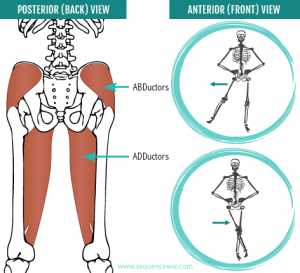
Yes, the main job of your hip adductors is to move the leg in toward the midline, and hip abductors to move the leg out. But another important role of those muscles is to stabilize your pelvis when you walk. Think about it for a moment – if you lifted your left leg up without changing the position of your pelvis, you would topple over to your left. To avoid falling, your right leg needs to shift more toward the midline, which is accomplished by your adductors contracting and your abductors stabilizing. This dance happens every time you shift the weight to one leg, which means every time you take a step. Therefore, the imbalance between your adductors and abductors will affect your walking gait and your balance.
If your abductors on one side are not strong enough to hold the pelvis leveled, the opposite hip will drop down as you walk. Or it can cause other muscles to compensate and become overly tight, which we will discuss later.
Misconception 2. Adductors are small, so they don’t have the power to affect the movement much.
Actually, your adductors are bigger than your hamstrings and only slightly smaller than your quadriceps, which means that they can generate incredible power. It also means that they can pull bones out of alignment if they get tight.
Misconception 3. It’s best to keep the feet together in Tadasana
Originally, keeping the feet together in Tadasana (Mountain pose) was meant to teach discipline to young boys. It has this military quality to it. For the rest of us, keeping the feet together is not very stable and causes us to tense the inner thigh muscles, creating an imbalance between the inner and outer hips. It is especially pronounced in women since we naturally have wider hips. We already spend way too much time in our lives tightening our inner thighs; wouldn’t it make more sense to work on aligning the joints (hip over knee over ankle) and restoring the balance between the inner and outer hip?
Misconception 4. Crossing the knees while sitting has nothing to do with my hip pain.
Whenever you sit with your legs crossed for an extended period of time, you tighten your hip adductors (inner thighs) and weaken your hip abductors (outer hip). As we sit more and more and walk less and less, this pattern of imbalance becomes more common and more pronounced.
This dysfunctional relationship can result in difficulties with walking and balance and hip pain. This pain is likely to show up while walking or while lying on an affected side at night. It can either be focused in the hip area or radiate down the leg. It can show up both on the side of the leg and the back of the leg, which means that sometimes it can be misdiagnosed as sciatica (of course, someone can have both issues at the same time).
If we want to restore balance to the adductor/abductor relationship, we need to both release tension in the adductors (inner thigh) and strengthen the abductors (outer hip). Remember that hip abductors play dual roles – as movers and as stabilizers, so ideally, we would want to use them in both capacities. In our yoga practice, we often work on the stabilizing role of the abductors by balancing on one leg. Here is an interesting thing: if the abductors on one side are not strong enough to hold the pelvis level, the QL (quadratus lumborum) muscle on the other side might step in to help pull the hip up. This means that in a pose like Vrksasana, for example, one hip will be pulling up.
In yoga practice, we also often do movements that stretch the inner thighs by abducting the legs. However, notice that none of these require an active engagement of the outer hip, which happens when you move the leg out to the side against gravity.
As a result, the typical pattern of imbalance remains largely unchanged for many people. Even if you manage to briefly stretch your inner thigh muscles, they will tighten right up from habitual movement patterns and the abductors will not be strong enough to resist it.
Misconception 5. Adductors have nothing to do with my piriformis
The infamous piriformis muscle is responsible for rotating your hip outward and is a common reason for the literal pain in the butt. Another job that your adductors AND abductors do is rotate your hip inward. If either of them gets tight, they can pull your hip inward, putting strain on the piriformis muscle.
Misconception 6. I can just do the “thigh machine” at the gym
Most fitness experts agree that the popular hip abductor/adductor machine is not the best way to strengthen your muscles. The problem is that this movement does not replicate anything that you do in your day-to-day life. Therefore, it is not a “functional movement.” In addition, using heavy weight on this machine can strain your back and tighten your IT band to the point of pulling your knee out of place.
To summarize, do not ignore your adductors/abductors. In your yoga practice, make sure to include the movements that contract and stretch your inner thighs, as well as movements that make your hip abductors both stabilize the pelvis and move the leg out to the side. And watch out for compensation patterns from other muscles!
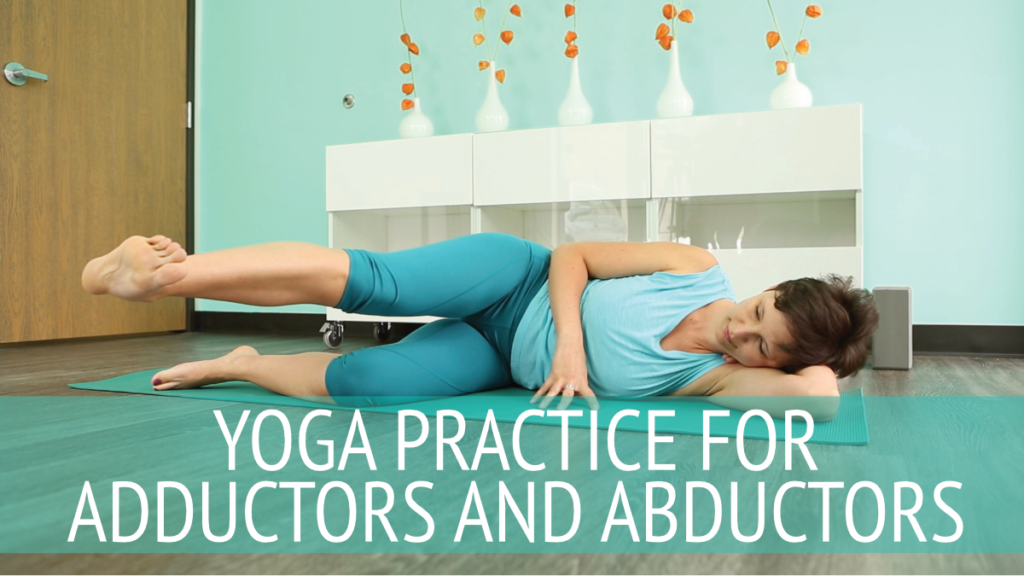
Check out this short yoga practice to promote a balanced relationship between your adductors and abductors.
Additional information about adductors and abductors
Sitting with knees crossed can increase your blood pressure

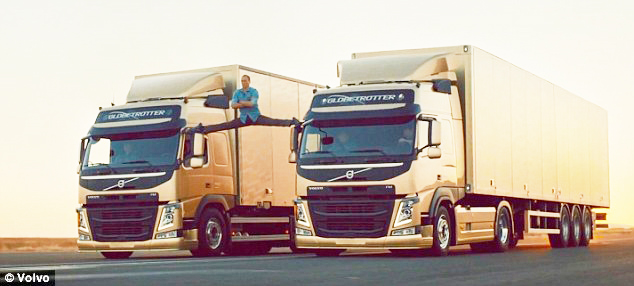
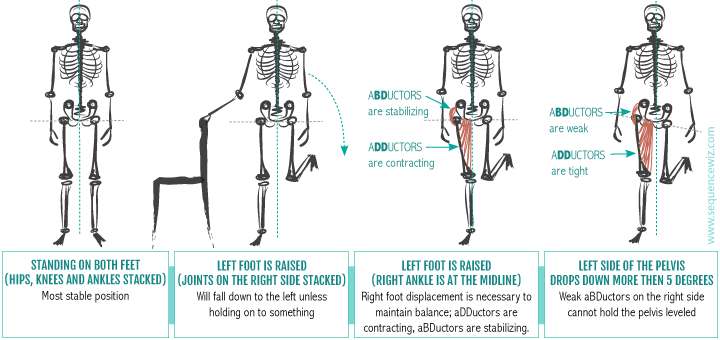


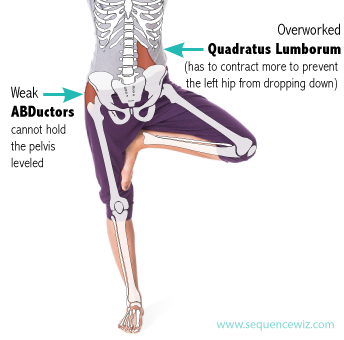
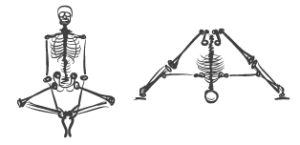

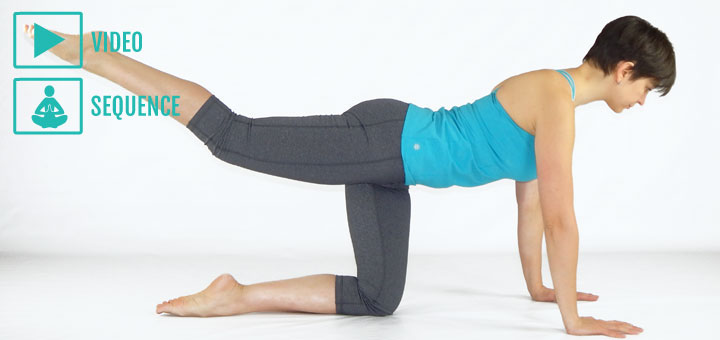
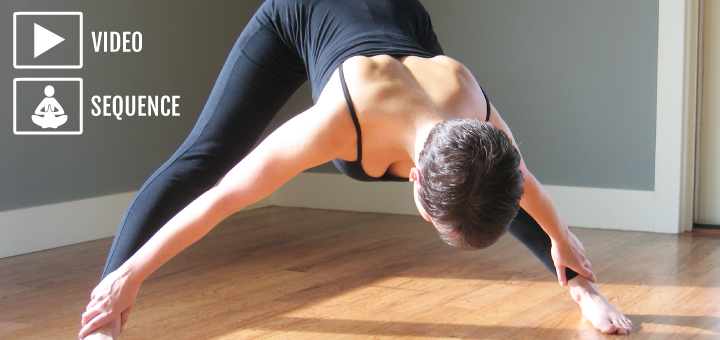






Another great article – keep up the good work. I really enjoy reading your straight forward discussion of anatomy and how it impacts both daily life/function and yoga asana. Thank you.
Thank you Katy! My teacher always asks: Are you for yoga or is yoga for you? I try to write from the prospective of “yoga for you”, meaning that we can use yoga as a tool to live happy fulfilling lives. I am glad that it comes across!
Love your blog! I’m learning a lot!
Thank you Susan! I am glad you find it useful.
Thank you for the very informative article. However i am still confused. I have pain in my right buttock which travels from the side towards the centre up and down in a straight line along the side upto my ankle. I wake up with a tingling sensation in my ankle and since yesterday, am experiencing some kind of numbness for a while when I wake up. My L4 and L5 have prolapsed and doctors tell me that, though the nerve is not compressed it is constantly getting irritated. However I have observed that the pain increases instantly if I try to walk at a decent pace for a while and when I sit for prolonged period or when I drive for a long time or when I sleep on my back and the right hip is pressed on the bed.
Please advice me on what exercises I should be doing. I am in this state since the last 6 months.
Thank you for your comment! Based on your description of symptoms, it sounds like sciatica. Have you been diagnosed with it before? Physical therapy is usually the best way to approach it, especially if the nerve irritation is coming from the spine. We have to be super-super careful here, and this sort of work is best done under close supervision of a professional. Where do you live? You can look up a qualified yoga therapist in your area here: http://www.viniyoga.com/learn-experience/viniyoga-teachers-and-yoga-therapists
Great article. Although I must say that after six years of implementing ways to turn on the abductors in a strong asana practice (ashtanga first and second series), things have gone full circle and they have become way stronger than the addductors causing constant pain in the outer hip. Since figuring out TFL strain was the culprit, I’ve had to abandon many of the techniques that worked so well for years (which most people do need as your article points out). By focusing more on adductor strengthening in most postures and other activities – the TFL strain vanished within a month (after lingering for a year). The experience has taught me that we really can’t give generalized advice, that context is so important. Practitioners of yoga asana who have developed floaty practices vs the general yoga practising public may often require very different advice. So important for yoga teachers to remember – thanks for giving context.
Hi Mike, thank you for your comment! I couldn’t agree more – balance and context are extremely important when working on any part of the body. So general advice remains just that, and individual investigation is much more effective. Thank you for sharing your story!
Hi, could you advice? I have pain in my left hip/buttock/sacrum area. During massage applied to my left piriformis I felt a lot of ” bad” pain, and the pain stayed for several days. It did not feel like the sort of good pain you would get if the muscle was just tight. I wonder if I have an overstretched, weak, tight piriformis on the left side? When I lie on my back and do a leg raise out to the side on the left, the top of the leg just ” flops” out of the hip onto the floor, which does not happen on the right side. It also feels wrong – uncomfortable. There is no feeling of strength or resistance. Generally speaking, I find it very hard to have control over my left leg in most of the poses – when compared to the range of movement and control in the right leg.
i’d appreciate if you can advise.
Hi Heidi! It’s hard to give you any sort of advice without watching you move, but i will try. Try this: Stand upright, shift the weight of the body to your right leg and extend your left leg forward with toes touching the floor. On the inhale draw a half-circle on the floor with your toes, moving the leg out and back; on the exhale reverse the movement and bring the leg out and back. The movement should be smooth and controlled (you can compare it on both sides and observe the differences). This is a good diagnostic tool to see if your hip muscles are strong enough and coordinated enough to follow the command from your brain. It is also a good move to train them. Give it a try and keep at it if it doesn’t cause pain. I will post the video of this move on the Instagram next week (ok.yoga) If it continues to hurt, you might want to see a doctor about it. Hope this helps!
I’m so glad i found your website! After several months of discomfort around my left hip and lower back that i havent been able to shake, i’ve got a new confidence that i may be able to find a solution or remedy on your website. My problem is this, due to a new job, i spent a lot of the start of this year with long periods of sitting at a desk, sometimes with my legs crossed and more than likely with bad posture. This has resulted in discomfort/tightness around hip joint, inner thigh and pelvis, most noticeable in sharp shots of pain when i move or bend in certain directions, put weight through the hip or lie on the left hip (especially on soft surfaces). In addition to this, i’ve been having episodes of sciatic pain in the left lower glute, possibly caused by a tight/weak glute. It does seem that sometimes the smallest of activities can set this off, but unlike the tight hip, i seem to be able to shake this off over a few days of stretching. That said, my thinking has always been that one is affecting the other (i.e. one is overcompensating for weakness in the other) and as such i’ve also struggled to relieve them both. I was also very… very slow in addressing the issue which seems to have resulted in a more chronic discomfort. My focus so far has been on stretching the glute (piriformus) and hip flexors, in the belief that tight hip flexors were the cause of the hip pain. However, after reading the above article, i’m starting to think it may be an abductor issue instead. A possible other issue is i’ve always just worked the saw hip, but is it possible that the tightness is caused by weakness in the opposite hip? Any advice you can give would be great.
Hi James – sorry to hear about your troubles! Yes, sitting with the legs crossed, especially if you tend to hike one hip higher then the other can do a number on your hips and weaken your abductors. The tricky thing about it is that once we develop certain habits of body positioning, we take them with us wherever we go and whatever we do. I would suggest that you try to strengthen your abductors instead of going straight for stretching the piriformis: contract-relax-stretch principle is usually the one I recommend. If your muscles are irritated, stretching and pulling on them will only make them more unhappy. And I love the expression about any physical pain: “It’s the victims who cry out, not the criminals” So the weakness and/or problem is often on the other side or with the antagonist muscle group. But regardless, strengthening the surrounding muscles on both sides should help. Try this short yoga sequence and see how it feels: http://sequencewiz.org/2015/03/06/yoga-for-abductors-adductors/ And let me know!
I fixed foot pain by paying some attention to my adductors. Got the spring back into my step.
Hello I really liked the article! I was wondering if damage to my adductors and abductors is causing my healing time to be stagnet with a herniated disk. I did weeks of intensive labor up four flights of stairs three months ago and the pain onset was slow, if I pulled one of these muscles would the onset of pain be extreme or would it show increasingly over the course of a day or two like mine did. When I go to sleep at night my right leg has pain (I have the sciatica from disk down to calve, sometimes foot, but the pain in the butt and back is really the most curious to me especially at night. (Not necessarily the most painful) The back pain wasn’t apparent for a few weeks post onset of pain/ injury. My physical therapist takes note to my alignment being messed up every appointment and while the disk herniation I realize can be a lot of the pain, the actual physical force of the muscles pulling my hip and pelvis alignment out is a mystery. I find my greatest improvements are extremely low use of muscles (or I relapse especially with the alignment pulling issue and night pain) I’ve been told to stay as active as I can with walking. I don’t know what to do anymore. I have compression over s1l5 and pinched nerves more heavily on one side. I’m 26 and have been doing hard labor for 8 years in masonry. I don’t want surgery and injections are the next step if I can’t figure out the problem.
Hi Matthew! So sorry to hear about your troubles. It is definitely a challenge when you do heavy duty labor, it takes a toll on your body. Sounds like you are working with a PT – is that helping? Herniated disk can certainly cause a lot of trouble, but so can muscular imbalance from the way we use our bodies. In my world we begin by investigating those imbalances and trying to correct them. You are so young, you cannot give up on movement or keep it to a minimum. It might be OK in the acute phase, but once that passes you will need to do some work to figure out those imbalances and try to correct them. With your line of work you might need to have a maintenance practice in place to counteract the challenges that intense labor puts on the body. If you want to begin the process of untangling of those movement patterns, please look for a qualified yoga therapist in your area, or you can schedule a Skype session with me, if you like. None of this can be resolved over email 🙂 I hope that you feel better soon!
Appreciate this post as well as your yoga videos for abductors and adductors. I a 57 year-old very active male that is 13 months into trying address a left-hip issue, and despite working with a variety of terrific PT folks, I have had only mixed success. There is little doubt in my mind that the problem arose from longstanding imbalances of the type you describe, and I HAVE made progress addressing dysfunctional movement patterns in glutes, hip flexors, and adductors. Unfortunately, I have not been as successful addressing the pain. Do you do Skype consultations, even just a one-timer to bounce around some ideas? Thank you.
Hi George! Sorry to hear about your on-going issues. I do offer Skype sessions and I would be happy to meet with you and discuss your situation specifically. You can get a bit more information about the sessions here and then send me an email if you decide to proceed. I will get you all the necessary information. I will be out of town though the end of January, but would be happy to schedule something for February. Let me know!
Hi Olga I have just finished watching your yoga session for the hip adductors and abductors with great interest, I will try these out. My question is that I have been having a great deal of tightness and irritation on the outer thigh and hip area due to a very inflamed IT band from cycling, my back also go affected so for the last year and a half I have been experiencing a great deal of discomfort, I cannot sit crossed legged due to tightness in the outer thigh and I also cannot bend forward from a sitting position with legs straight in front, I was able to do these positions before all the trouble started with my hip. An MRI of my back shows mild disk protrusion with slight degeneration of the facet joints but nothing points towards the discomfort I am experiencing . My hips and thighs seem to get even tighter after stretching so at the moment I am unable to do hardly any form of excercise apart from walking. I use to do yoga and pilates very regularly so I am finding it all a bit upsetting now and I am beginning to wonder if I will ever get back to normal. My question is should I let all of this discomfort settle down before I attempt to try your session of should I go ahead and only do what I feel comfortable with. I sometimes wonder if I am not allowing my body to heal as I keep attempting to strengthen and stretch my hips. Thanks .
Post came at an opportune time for me. Just learned I have a mild hip bone degenerative issue.
Thank you for this information! I followed a Google search for outer thigh/hip pain and I’m glad I clicked on this link! I already have started a yoga practice to help with my Osteonecrosis and I will certainly now be practicing more Asanas focused on the abductors. I’m definitely bookmarking your site!
Thanks for this explanation. I’m going to use it to educate my client. I’m a postural alignment specialist certified by Egoscue university and know the importance of balancing opposing muscle groups. Your article contained some great observations and pointers.
Please I have my right knee slightly turned inward as knock knee so, but realised my abductor on my right hip is not working its stiff and tight so please I need exercises to strengthen and stretch it makes my walk looks like a knock kneed so please help
Hi Emmanuel, let’s wait for Olga to reply but what we often see that helps people with your posture is to work on the glutes (as they function as adductors). Don’t just work on the right side, try to work on both sides always and do on the left side what you do on the right side. Eventually they will balance out and the right side will become stronger. There are several exercises we use (with the Egoscue method) for example hooklying glute contractions, standing glute contractions (you could start with that one – see here for a link: http://www.egoscue.com/WebMenus/ECiseHTML/255.html in case the link doesn’t get through just Google “Egoscue standing glute contractions”) or inline glute contractions.
What might also help is Inner/outer thighs as that works both the adductors and the abductors. See here http://www.egoscue.com/WebMenus/QTVideo/38.html
But as I always recommend is to look at the entire body/posture as one thing cannot be “spot fixed” or seen apart from other deviations. So I always recommend to get your posture checked out by a trained expert. Nevertheless these exercises are harmless and you can give them a try first.
Thank you for your help Patrick!
Hi Emmanuel! I agree with Patrick – we cannot “spot fix” in the body, there are always way too many different things that come into play. I would recommend that you find somebody to work with individually who can evaluate the relationships in your entire body. You can check out this list of viniyoga practitioners to find one in your area. I hope this helps!
Hi Olga,
So I think my adductors and abductor muscles are definitely out of whack. On my left leg I have decent external rotation of the hip and poor internal rotation of the hip; and on my right leg I have very poor external rotation and good internal rotation of the hip (crazy how backwards they are!). Also my gluteus medius, TFL and IT band are quite tight on both sides. Also my inner thigh muscles are on my left are more flexible than on my right. So I’m thinking that tight adductors on my right side are preventing proper external rotation on my right hip. I don’t really get much hip pain or low back pain from this but I want my hips to have great external rotations and internal rotation and more or less equal on both sides.
My guess is that I just need to focus on strengthening and stretching both of my adductors and abductors. Is that right? How can I make my hips even?
Hi Olga,
Thanks for the informative article. Please am a woman above 60yrs, am having a kind of frequent pain(feels like a painful pull) on the side of my upper buttocks, the pain also travels down to the thigh sometimes. Please your advice would be really appreciated, thanks and keep up the good work.
Wow. this is great info. I’ve been running for 35 years. I’ve been telling people I have a weak pelvis/hip/hamstrings for years without knowing exactly WHAT my issue is. I’ve always been careful and taken time off when I need it.. but I’ve never really known what my problem is…. Your article addresses exactly my problem.
Hi! I have super flexible hip adductors from gymnastics, dance, and aerial. But my hip abductors are extremely tight and painful. I have trouble engaging the muscles when I need to while dancing because of how tight they are. Is there a relation between my flexible adductors and the uncomfortable and tight abductors? Also, are there any deep massages or stretches that will reach deep into the muscle that you can recommend?
Thanks!
Hi Sarah! I see this kind of relationship rather often. You can try massage, of course, to release tension, but the release would likely be temporary until you take time to rebalance the entire relationship. Try this yoga practice designed specifically for that purpose; you might also get some useful information about your imbalances.
Hi there,
my issue, is when I lie down and turn to the right side as soon as hip is pressed I get a shooting pain in that area. I also noticed when I sit in the toilet pain shoots in the hip. I got a massage thinking it would alleviate the problem i felt good but after awhile sitting on the recliner was so painful.
Which doctor can diagnose weak adductors and help me with exercises?
This article is really helpful thank you so much. I have been suffering pain especially when seated, I believe that part of the cause is a major weakness of the abductors on my left side. With muscular imbalances, should you concentrate on the weakened side to build strength or work both sides evenly?
Thanks in advance Helen
This is such a good article. After 30 years of searching, probably 50 ‘specialists’ and 4 operations on my ankle due to a lateral force on my right foot I think the answer is contained in this article. If anyone can help me contact the author I would be very grateful. Ian
Love this
I really enjoyed this article. I have a lateral pelvic tilt which has caused me much pain and I was trying to understand the interplay between the QL, hip adductors and abductors as stabilizers, not any easy task! That is until I read your very comprehensive article. Thank you so much.
Can’t wait to get more information about the piriformis. I am having bad pain in my right buttocks, hip area and sciatic pain in the outer thigh & down the leg. HELP
I was doing an adductor test, to see what other muscles tighten up when I do it. Well when I have a block in between my knees, while I’m laying on my back, my right adductor fires and my knee goes in slightly due to the muscle contracting. The left adductor has no idea what in the world is going on. My butt is not clenched, though my hamstrings, quads, and hip flexors are tight.
Then I do it side lying, and everything is tight. Glutes, hamstrings, quads, and hip flexors. And not even sure if my inner thighs were even firing in this position.
What do I do?
I want to cry joyful tears! I’ve been dealing with left hip/IT band/glute pain for three years. Now my adductirs have started hurting, too. Mainly on my left side as well. Finding your yoga videos/site has been beyond helpful! Not to mention how helpful they are to my pain levels, but your voice is so soothing and I also enjoy that you don’t have music playing during your practice. Thank you for taking the time to help people across the world!
One of my patient was suffering from bad pain in his right buttocks and hip area due to his sitting position while working. I suggested him to sit in a right position and to explain the importance of right posture, your this useful guide helped me a lot. Keep sharing such useful guides to help the community